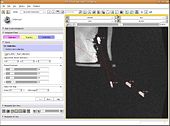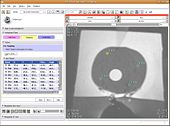Difference between revisions of "DBP2:Queens:Roadmap"
| Line 35: | Line 35: | ||
|valign="top"|[[Image:TRProstateTargeting.jpg|thumb|170px|Trajectory calculation from target locations]] | |valign="top"|[[Image:TRProstateTargeting.jpg|thumb|170px|Trajectory calculation from target locations]] | ||
|} | |} | ||
| + | </center> | ||
=== Schedule === | === Schedule === | ||
Revision as of 20:34, 12 August 2008
Home < DBP2:Queens:RoadmapBack to NA-MIC Internal Collaborations, JHU DBP 2
Objective
We would like to create an end-to-end application within the NA-MIC Kit to enable an existing transrectal prostate biopsy device to perform multi-parametric MRI guided prostate biopsy in closed-bore high-field MRI magnets.
This page describes the technology roadmap for robotic prostate biopsy in the NA-MIC Kit. The basic components necessary for this application are:
- Tissue segmentation: Should be multi-modality, correcting for intensity inhomogeneity and work for both supine and prone patients, all imaged with an endorectal coil (ERC).
- Registration: co-registration of MRI datasets taken at different times, in different body positions, and under different imaging parameters
- Prostate Measurement: Measure volume of all segmented structures
- Biopsy Device Parameters: Geometry, kinematics, and calibration/registration of the robot system must be available in some form. This capability is not currently part of the NA-MIC kit. The application will be modular, to enable use of different devices.
- Tutorial: Documentation will be written for a tutorial and sample data sets will be provided to perform simulated biopsies.
Roadmap
We will obtain a biopsy plan from multi-parametric endorectal image volumes, executable with an existing prostate biopsy device. The system will be will be implemented under Slicer3 as an interactive application.
Current Status of System Components
- Segmentation: Semi-automatic segmentation has been implemented by Fichtinger et al. Statistical atlas based segmentation has been prototyped by Tannenbaum et al. Pose-independent segmentation (workable in both supine/prone) is being implemented.
- Registration: contour based registration has been prototyped by Fichtinger et al., needs to be re-implemented with native NA-MIC tools.
- Prostate Measurement: Prototyped by Fichtinger et al., needs to be re-implemented with native NA-MIC tools.
- Device Modeling: Prototyped by Fichtinger et al, needs to be re-implemented with native NA-MIC tools.
- Biopsy Planning: Clinically functional, needs to be implemented with native NA-MIC tools
- Tutorial: Not yet started. It will be derived from the actual clinically-functional system, with demo data.
Slicer Transrectal Prostate Biopsy Module
The primary goal for the roadmap is to develop an interventional module for Slicer3 for MRI-guided prostate biopsies. This module and the accompanying tutorial will serve as a template for interventional applications with Slicer3.
Schedule
Data Collection: Done. Initial data available, hand segmented for ground truth.
Segmentation: We plan to use shape-based segmentation methods for the MRI prostate data. Several parts of the procedure have already been implemented with NA-MIC tools such as the conformal flattening procedure. Spherical wavelets for shape analysis are already available in ITK. Despeckling techniques will be used to enhance ultrasound imagery as a pre-processing step for segmentation of the prostate data.
System Implementation: Apart from the one research element (segmentation), the rest of the project is a massive software engineering effort, and will follow these major milestones and schedule:
Application Workflow Development:
10/15/2007 Define the workflow for the application (David, Csaba, Gabor) --- DONE ---
10/22/2007 Create GUI templates for the workflow steps (David) --- DONE ---
Device Modeling:
12/15/2007 Conversion of engineering data into VTK-viewable objects (David) -- DONE --
Data Display:
12/15/2007 Provide display logic for targets and prostate outlines (David) --- DONE ---
Measurement Tools:
07/01/2008 Semi-automatic identification of fiducials via thresholding & centroids (Csaba) --- DONE ---
07/01/2008 Logic for robot registration with fiducials (Csaba) --- DONE ---
08/01/2008 Prostate measurement tools (use existing NA-MIC tools) (David) --- IN PROCESS ---
Biopsy Planning:
07/01/2008 Calculations for robot trajectory based on target position (Csaba) --- DONE ---
08/08/2008 Implement planning tools (display, logic) in Slicer3 (David) --- MOSTLY DONE ---
08/15/2008 Verification against pre-existing software and data (David, Siddharth)
Robot positioning:
08/22/2008 Integrate optical encoders with our Slicer module (David)
08/22/2008 GUI targeting readouts for optical encoders (David, Siddharth)
Integration of contour-based prostate display into Slicer3:
08/29/2008 2D Contour outline display of 3D models in Slicer (David)
Verification and testing of integrated system
09/12/2008 Workflow validation (Siddharth, David)
09/12/2008 Complete testing, performance characterization (Siddharth)
Tutorial and Documentation
Continuous unit documentation (David)
09/26/2008 Complete tutorial with example data
Team and Institutes
- PI: Gabor Fichtinger, Queen’s University (gabor at cs.queensu.ca)
- Co-I: Purang Abolmaesumi, Queen’s University (purang at cs.queensu.ca)
- Software Engineer Lead: David Gobbi, Queen’s University (dgobbi at cs.queensu.ca
- Software Engineer Support: Siddharth Vikal, Queen’s University (siddharthvikal at yahoo.com)
- JHU Software Engineer Support: Csaba Csoma, Johns Hopkins University, csoma at jhu.edu
- NA-MIC Engineering Contact: Katie Hayes, MSc, Brigham and Women's Hospital, hayes at bwh.harvard.edu
- NA-MIC Algorithms Contact: Allen Tannenbaum, PhD, GeorgiaTech, tannenba at ece.gatech.edu
- Host Institutes: Queen's University & Johns Hopkins University

